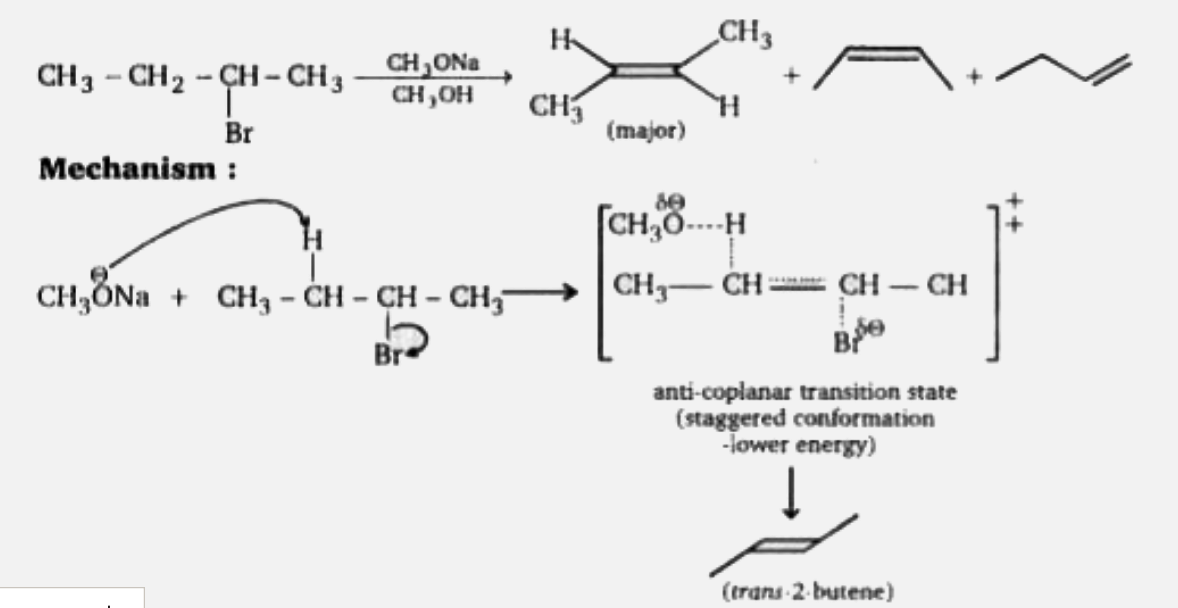Increasing the concentration of a nucleophile in a typical SN2 reaction by a factor of 10 will cause the reaction rate to :Solution in Kannada
increase by a factor of 10
increase by a factor of 102
decrease by a factor of 10
remain about the same
The correct Answer is:A
Rate of SN2 = K [ Substrate] [Nu]
Topper's Solved these Questions
- ALKYL HALIDES (SUBSTITUTION REACTIONS)BOOK - MS CHOUHANCHAPTER - ALKYL HALIDES (SUBSTITUTION REACTIONS)EXERCISE - LEVEL-2
41 Videos
- ALKYL HALIDES (ELIMINATION REACTION) BOOK - MS CHOUHANCHAPTER - ALKYL HALIDES (ELIMINATION REACTION) EXERCISE - LEVEL-2
25 Videos
- AMINESBOOK - MS CHOUHANCHAPTER - AMINESEXERCISE - Level-2
1 Videos
Similar Questions
Statement - 1 : Nucleophilicity order in polar-protic solvent is I−<Br−<Cl−<F−
Statement-2 : Due to bigger size of I it is less solvated in polar-protic solvent.
View SolutionComprehension
E2 raction → Elimination bimolecular
In the general mechanism of the E2 reaction a strong base abstract a proton on a carbon atom adjacent to the one of the leaving group. As the abstracts a proton , a double bond forms and the leaving group leaves.

Identify the rate of reaction of given compounds in E2 reaction:

View SolutionFive amine syntheses are outlined below. In each reaction box enter a single letter designating the best reagent and conditions selected from the list at the bottom of the page.


View SolutionThe rate of reaction between A and B increases by a factor of 100, when the concentration with respect to A is increased 10 folds, the order of reaction w.r.t. A is
View SolutionDecreasing the concentration of an electrophile in a typical SN2 reaction by a factor of 3 will cause the reaction ratio to:
View SolutionIncreasing the concentratuion of an electropille in a typical S_(N^(2)) reaction by reaction by a factor of 3 and the concentration of the nuckleophile by a factor of 3 will change the reaction rate to:
View SolutionThe rate of reaction between A and B increases by a factor of 100, when the concentration with respect to A is increased 10 folds, the order of reaction w.r.t. A is
View SolutionIn SN2 mechanism, the rate of reaction is proportional to concentration of _________.
View SolutionWhen the concentration of nucleophile is reduced to half, the rate of SN2 reaction is decreased by
View SolutionThe rate of reaction between A and B increases by a factor of 100, when the concentration with respect to A is increased 10 folds, the order of reaction w.r.t. A is
View SolutionThe rate of reaction between A and B increases by a factor of 100, when the concentration with respect to A is increased 10 folds, the order of reaction w.r.t. A is
View SolutionIf I increase the concentration of nucleophile the rate of reaction will?
View SolutionThe rate of reaction between A and B increases by a factor of 100 , when the concentration with respect to A is increased 10 folds, the order of reaction w.r.t. A is
View SolutionWhen the concentration of nucleophile is reduced to half, the rate of S_(N^(2)) reaction is decreased by
View SolutionWhen concentration of alkyl halide is tripled and the concentration of OH− ion is reduced to half, the rate of SN2 reaction increased by
View SolutionBy increasing the temperature by 10°C, the rate of forward reaction at equilibrium is increased by a factor of 2. The rate of backward reaction by this increase in temperature
View Solution
